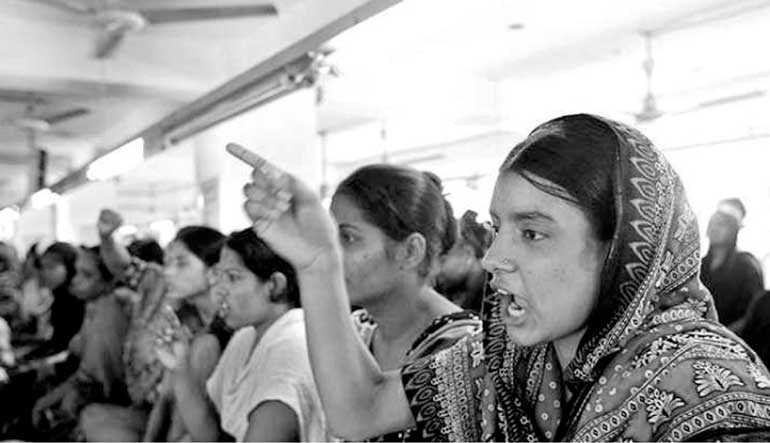Thursday Apr 18, 2024
Thursday Apr 18, 2024
Saturday, 19 January 2019 00:10 - - {{hitsCtrl.values.hits}}

Striking Bangladeshi garment workers
 The recent week-long mass protests by garment workers in Bangladesh came to an end after an upward revision of wages for six classes of workers. But even after the upward revision, the Bangladeshi garment worker gets less than what workers in comparable countries do.
The recent week-long mass protests by garment workers in Bangladesh came to an end after an upward revision of wages for six classes of workers. But even after the upward revision, the Bangladeshi garment worker gets less than what workers in comparable countries do.
Therefore, unless the wages issue is addressed in earnest, and with a long-term perspective, it will continue to torment the country’s single largest foreign exchange earner which is presently raking in over $ 27 billion a year.
However, wages are not the only issue facing the industry. Overall working conditions are appalling, reports say. Productivity is low. Poor infrastructure has led to horrendous accidents as in 2012 and 2013. And given the callous attitude of the managements, the unions and the Government, there is no guarantee that such things will not recur.
Even as the number of garment factories grew exponentially from 384 in 1983 to 4328 in 2016, and to be almost 5,000 now, productivity fell to $ 0.22 per hour in 2017, says Tariq Adnan in www.omicsonline.org.
Dilapidated conditions and inadequate infrastructure led to the death of 200 workers at the Tasreen garment factory in 2012, and 1134 died in the Rana Plaza disaster in 2013, in which an eight-floor building collapsed.
Wage increases
After the recent week-long strike, the “gross wage” in respect of Grades 1 to 6 went up. In Grade 1, the raise was from Tk. 17,510 to Tk. 18,257 ($ 209.3 to 218.6). In Grade 6, it went up from Tk. 8,405 to Tk. 8,420 ($ 100.4 to $ 100.66).
The “basic wage” in Grade 1 went up from Tk. 10,440 ($ 124.8) in 2018 to Tk. 10,938 ($ 130.7) in 2019. In the case of Grade 6, the hike was from Tk. 4,370 ($ 52.2) to Tk. 4,380 ($ 52.3).
But still, these wages are among the lowest in the world of garment manufacturing. According to ILO’s figures for 2013, the average monthly wage of a garment worker in India was $ 71; in Vietnam it was $ 78; in Cambodia $ 80; in Indonesia $ 84 and in Malaysia $ 247. But in Bangladesh it was $ 68.
According to Tariq Adnan, a Bangladeshi has to earn at least $ 314 per month to house, clothe and feed a family of five. But even the top most Bangladeshi garment factory worker earns only $ 218 per month.
And if a five-member family is to get the right amount of nutrition and calories, it has to spend $ 435 on food alone. But as of now, an average worker’s family spends only $ 168 on food. Adnan’s survey found that 70% of the garment workers complained that they had no savings.
Despite low productivity per worker, Bangladesh is the second largest garment exporter in the world catering to up-market outlets in the EU and US. This is because of its low wages. With massive profits guaranteed, many entrepreneurs have invaded the apparel sector and put up factories often breaking rules.
Hunger for profits makes managements exploit helpless female workers who comprise 80% of the workforce. Shanjida Shahab Uddin, writing in www.southasiajournal.net in 2015 said that women workers in the Ready Made Garment (RMG) industry had to face severe health related complications due to unsafe factory conditions; stringent rules; frequent overtime work along with daily long working hours; and the absence of maternity leave.,
“According to Bangladeshi law, workers are supposed to work an eight-hour shift. However, garment workers are forced to work extra hours on a daily basis in order to meet production targets set by factory owners. Research shows that around 80% of women workers leave the factory between 8 p.m. and 10 p.m. after starting work at 8 a.m., violating Bangladeshi labour laws which state that under no circumstances should daily working hours exceed 10 hours,” Shahab Uddin pointed out.
“The worst part is that, after doing overtime, women workers often remain unpaid. Factory owners cut their overtime payment whenever they want. Female workers are cheated more often than men, as they are seen as quieter and less likely to complain. It is also noticed that only a small number of the workers receive letters of appointment, while most of them carry only a factory identity card,” she added.
Most of the factory owners do not follow the 2006 Bangladesh Labour Law, which protects the right to maternity leave.
“In 2011, the Prime Minister of Bangladesh announced that maternity leave would be extended to six months, but it remains unclear whether this will be implemented outside the civil service. Factory owners set various types of maternity leave provisions but these were not favourable to women workers.
“A worse consequence is that most of the time, women workers have to lose their job after giving birth. In some factories, the owner accepts women workers returning to work after giving birth but they have to work at a lower grade. They cannot work at their previous grade.”
“Another inhuman practice which impacts most of the women workers is that many of them are forced to work during the final stages of pregnancy to meet the production targets which seriously hampers the health of both mother and child,” Shahab Uddin noted.
“Long working days along with frequent overtime work destroys necessary rest periods. It creates hurdles for necessary domestic work. Most of the time women workers have to go to their home late at night and again come back to the factory for work early the next morning. It puts a great load on them as they have to complete their household chores within a very short time.
“Naturally, these excessive pressures have had an adverse impact on women workers’ health and mental stability. Women workers reported concerns over long periods of separation from their children, particularly women with young children who are being breastfed,” the writer noted.
Weak trade unions
One of the reasons for the garment workers’ pitiable plight is the fact that the trade unions in the garment sector are weak and too few in number.
According to The Daily Star the latest spell of protests against disparity in wages was not guided by union leaders but was spontaneous. In fact, the workers said that they did not want the union leaders to lead because these leaders were hand in glove with the managements.
Trade unions are not being formed in the sector though the government had brought down the stipulation for union formation from 30% of the workforce to 20%. Managements have discouraged the formation of unions, though it is universally accepted that unions help bring about settlements and do not always cause unrest.
According to www.lawatthemargins.com, unionising workers in Bangladesh is not an easy task. Trade union organisers say that they get beaten up by the police or the factory hooligans.
The high profile murder of labour leader Aminul Islam in 2012 (allegedly by the National Security Intelligence Agency of Bangladesh), reveals the severe constraints under which trade unions seek to improve workplace conditions, the website said.